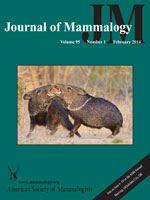Communication in solitary and social mustelids has been mainly studied in terms of olfactory abilities. However, most otters appear highly social and vocal, but little is known about the role of vocal signals in communication in those species. An analysis of the airborne vocal repertoire and social networks of Asian small-clawed otters (Aonyx cinerea) is reported herein. The vocal repertoire of a captive group of 10 individuals was composed of 4 context-dependent vocalization units, which were emitted alone, repeated, or combined in a nonrandom way, resulting in 7 vocalization types. Individuals varied in their preference to use certain vocalization types and to maintain bonds with some particular group members. Older, larger, and heavier otters produced lower-frequency sounds. Thus, Asian small-clawed otters are clearly social and possess a high potential for vocal communication, such as acoustic coding of messages about ongoing social activities and biologically important characteristics about the sender. Future comparative studies of mustelids will tell whether solitary species may use essentially olfactory communication, whereas social species use multimodal communication, including vocal cues.
How to translate text using browser tools
1 February 2014
Vocal repertoire, individual acoustic distinctiveness, and social networks in a group of captive Asian small-clawed otters (Aonyx cinerea)
Alban Lemasson,
Marie-Ana Mikus,
Catherine Blois-Heulin,
Thierry Lodé
ACCESS THE FULL ARTICLE

Journal of Mammalogy
Vol. 95 • No. 1
February 2014
Vol. 95 • No. 1
February 2014
Aonyx cinerea
Asian small clawed otter
mustelid
otter
social network
vocal repertoire
vocalization




